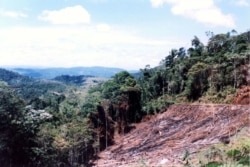Scientists say evidence is mounting that trees can have a far-reaching effect in stemming global warming by removing huge amounts of carbon from the atmosphere. A recent study bolsters this idea, and tree-planting advocates say it’s something they’ve known for decades.
The recent European study published in Science magazine July 5 says trees could potentially absorb two-thirds of the carbon that has been added to the atmosphere as a result of human activity since the Industrial Revolution.
The study, headed by researchers at the Crowther Lab at ETH Zurich, a technical university, found that an extra 500 billion trees, covering an area roughly the size of the United States, could remove 200 gigatons of carbon from the air when they reach maturity.
The study’s authors say that combined with reduced greenhouse gas emissions, adding so many extra trees could replenish the world’s shrinking stock by 2050 and provide the most effective climate change solution to date.
The scientists say that limiting global warming to 1.5 degrees Celsius by 2050, the goal of the U.N.’s Intergovernmental Panel on Climate Change, will require an extra billion hectares of forest, an increase of nearly 20% over existing forest land.
It is a race against time, however, since a warming planet means the area available for tree planting is shrinking.
Act locally
There are a few remaining trees in a section of the Angeles National Forest, northeast of Los Angeles, where volunteers are removing invasive species such as mustard and types of thistle, and restoring native plants “... about 40 different species,” said Thierry Rivard of the nonprofit TreePeople.
The newly sown plants are grasses, Rivard said. “Some of them are what you would call shrubs. Some of them are trees — oaks, elderberries.”
They had thrived in this area in a balanced ecosystem until recent times, when they were crowded out by other species brought by human activity.
On a recent weekend, dozens of volunteers pulled out invasive plants and carried water buckets through the rolling hills to nurture saplings.
The restoration will make the hillsides more resistant to wildfires, since invasive plants dry out in the summer to create conditions for flash fuels.
At the heart of the project are trees.
“Trees have multiple benefits,” said Cindy Montanez, the CEO of TreePeople. “Trees shade humans, the environment, as we see dramatic increases in extreme heat. Trees help retain water in situations where there’s flooding (and) we’re trying to prevent water runoff,” she added.
Reducing deforestation
A major effort to reduce deforestation and expand existing forests is underway around the world, including the Thirty Hills project in Sumatra’s forests, and Trillion Trees, with efforts focused, so far, in parts of South America and Africa .
Both projects were undertaken by the World Wildlife Fund and partner organizations as part of a comprehensive approach that encourages ecologically sound industries. For example, forest-friendly methods of cocoa production in Africa and honey production in Indonesia.
Forest restoration is not without challenges, and researchers must take into account “areas where we have grazing lands, or we have important grasslands, or we need to consider what the land ownership is,” said Christa Anderson, a research fellow with the World Wildlife Fund.
Anderson said studies have found that so-called boreal forests in northern latitudes absorb light from the sun and can have a warming effect, and that reforestation works better in some places than others. The research paper in Science says six countries have the potential to restore more than half of the needed trees: Russia, the United States, Canada, Australia, Brazil and China.
Scores of governments have pledged to help, joining the Bonn Challenge, an effort to restore 150 million hectares of forest by 2020 and 350 million hectares by 2030.
“It’s one of the pieces, and another huge piece is reducing our energy and industry emissions. We really need both things,” Anderson said.
Individuals and local communities can also help, Montanez said.
“Take personal responsibility, help plant trees,” she said. “It’s fun, it makes our communities greener, more climate-resilient, more sustainable.”
And trees make our planet more livable, she added.












